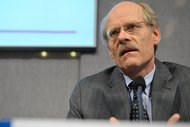Applications for benefits dropped 16,000, the Labor Department said Thursday. The four-week average declined 4,500 to 357,500.
Jobless claims are a proxy for layoffs. When they decline, it signals that companies are cutting fewer jobs.
Still, layoffs are only half the equation. Businesses also need to be confident enough in the economy to step up hiring. Many companies have been advertising more jobs but have been slow to fill them. Job openings jumped 11 percent during the 12 months that ended in February, but the number of people hired declined, according to a Labor Department report this month.
The still-uncertain economy has made many companies reluctant to hire. Some employers appear to be holding out for perfect job candidates. In particular, companies say they cannot find enough qualified candidates for high-skilled manufacturing and engineering jobs.
Still, most economists were encouraged by Thursday’s report on unemployment benefits, though some cautioned against reading too much into one week’s data. “The downtrend in unemployment remains on track,” said Jim O’Sullivan, chief United States economist at High Frequency Economics.
In March, employers added only 88,000 jobs. That was a sharp drop from the previous four months, when hiring averaged 220,000 a month.
The unemployment rate fell to a four-year low of 7.6 percent in March from 7.7 percent in February. But the drop occurred because more people out of work stopped looking for jobs. The government does not count people as unemployed unless they are actively looking for work.
More than five million Americans received unemployment aid in the week ending April 6, the latest data available. That is about 80,000 fewer than the previous week. Some recipients may no longer receive benefits because they have found jobs. But many have used up all the benefits available to them.
The economy is expected to have grown at a much quicker pace in the January-March quarter, and the government will give its first estimate on growth in the nation’s gross domestic product on Friday. Many economists forecast that growth accelerated to an annual rate of more than 3 percent in the first quarter, up from just a 0.4 percent rate in the fourth quarter.
Article source: http://www.nytimes.com/2013/04/26/business/economy/fewer-layoffs-but-employers-are-still-hesitant-to-hire.html?partner=rss&emc=rss




